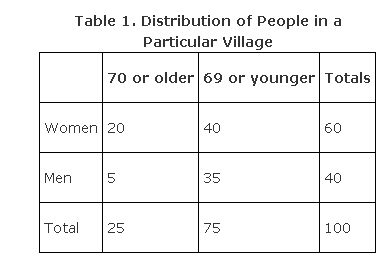Sometimes you have more information than simply total outcomes and favorable outcomes; hence, you are able to make more informed judgments regarding probabilities. For example, suppose you know the following information: In a particular village, there are 60 women and 40 men. Twenty of those women are 70 years of age or older; five of the men are 70 years of age or older (see Table 1).

What is the probability that a person selected at random in that town will be a woman? Because women constitute 60 percent of the total population, the probability is 0.60.
What is the probability that a person 70 years of age or older, selected at random, will be a woman? This question is different because the probability of A (being a woman) given B (the person in question being 70 years of age or older) is now conditional upon B (being 70 years of age or older). Because women number 20 out of the 25 people in the 70‐or‐older group, the probability of this latter question is  , or 0.80.
, or 0.80.
Conditional probability is found using this formula:

which is read: The probability of A given B equals the probability of A and B divided by the probability of B. The vertical bar in the expression A|B is read given that or given.
|
|